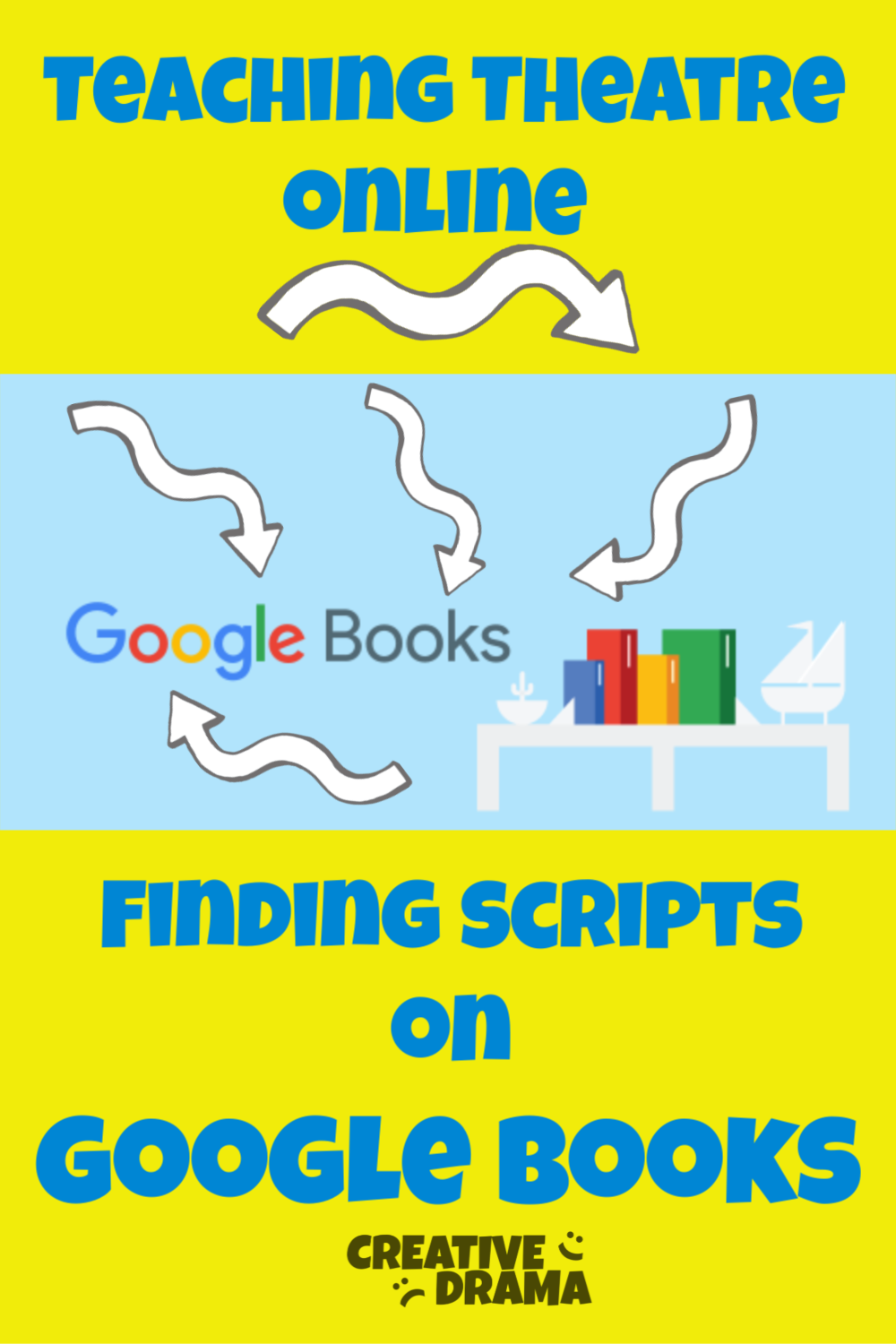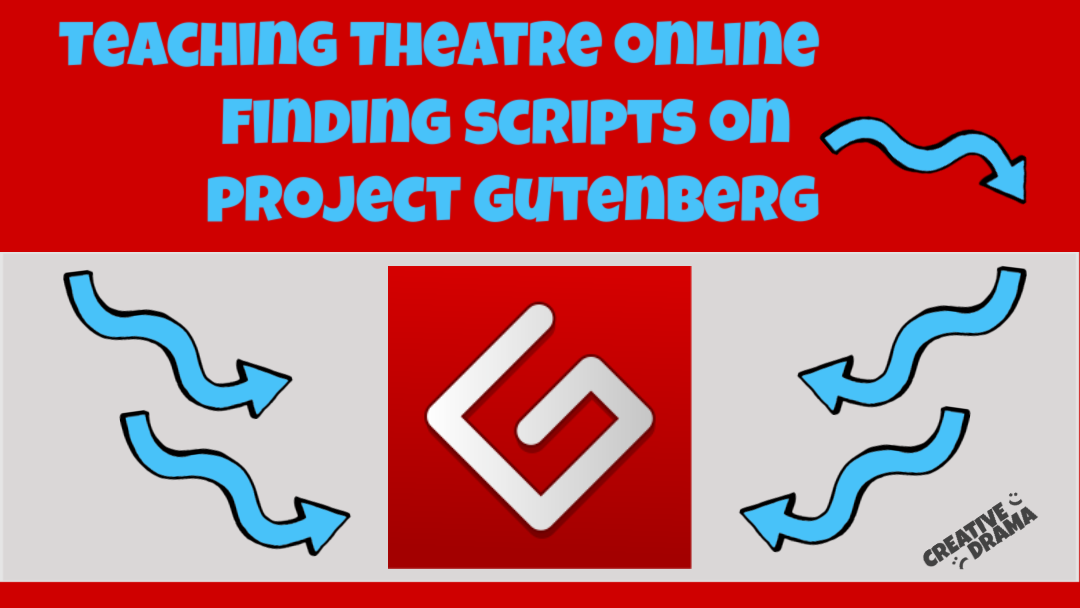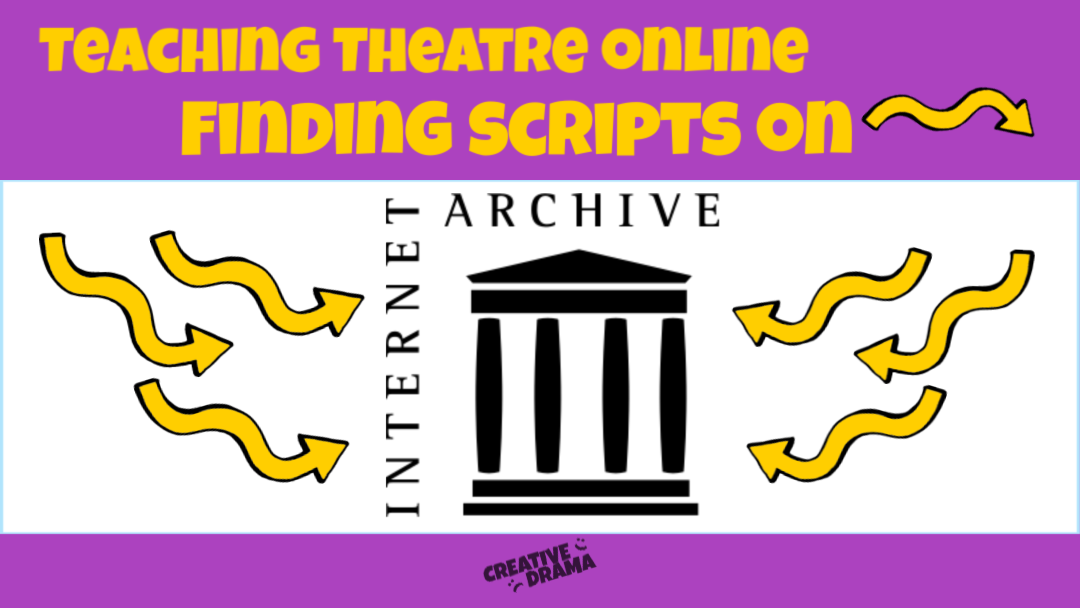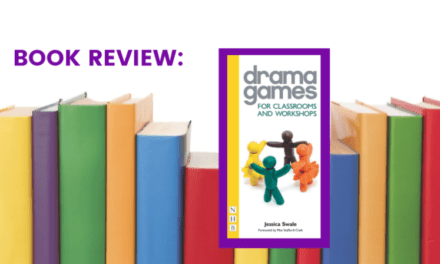Teaching Theatre Online – Finding Scripts on Google Books
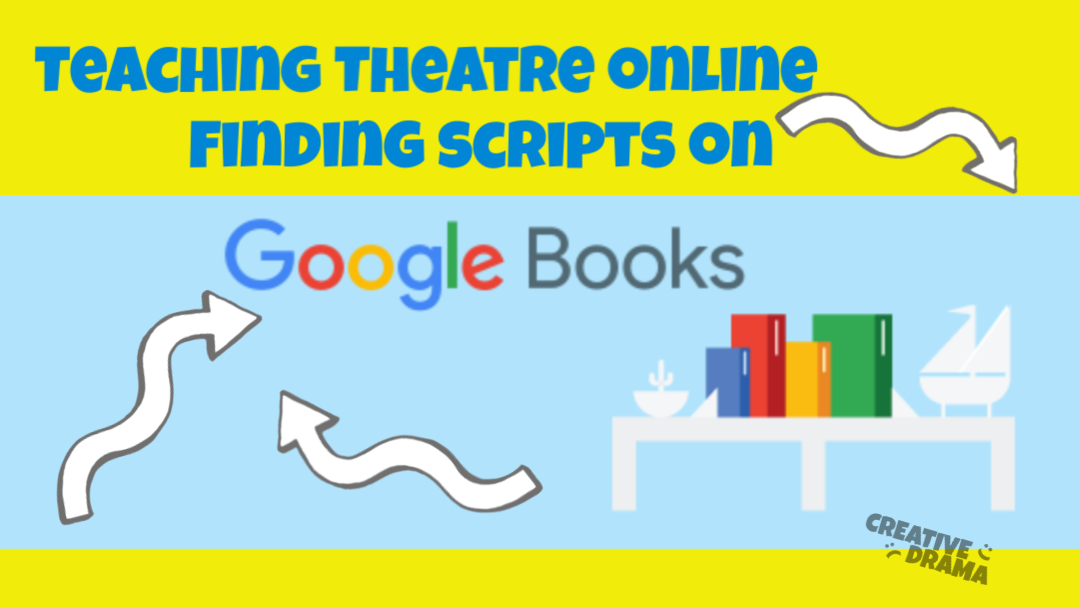
Are you teaching theatre online and looking for scripts for your students to read and perform?
As a teacher-director, you likely have a bookcase or filing cabinet filled with individual scripts, collections of plays, and anthologies…in your classroom. Even if you have a personal library at home, it’s a logistical challenge to get those physical copies into your students’ hands.
One way your students can access material easily is through Google Books.
Google Books, also known as the Ocean Project, started in 2002. Google Books has scanned over 40 million titles to date.
The project indexes public domain, out-of-print, and current books. You can read sample pages from some very recent books, and purchase ebooks as well.
A general search on Google Books will return four different types of results:
Full View – You’ll be able to read the entire work via Google Books – there will be “Read for Free” and “Download PDF” options on the book’s page.
Limited Preview – You can read a few pages or sections from the book, typically the Introduction, Table of Contents, and the first chapter (or part of a play) in the book. You may be able to see later pages, but they might be completely out of context.
Snippet View – Google will show partial excerpts from a few pages that contain search terms.
Preview Unavailable – Google Books will provide publication information and a description of the work; you may see a cover image.
You can find further information about Google Books here:
Advanced Search
Performing an advanced search on Google Books allows you to limit results by full-text, publication date, and language.
When you’re looking for public domain pieces, limit your search to “Full view only,” and select a date range ending in 1924. You can search as far back as the 16th century, but because the files are scans of physical books, works from before 1700 are often more difficult to read.

Google Books Advanced Search
If you have a Google account, you can save texts in your Google Play library:
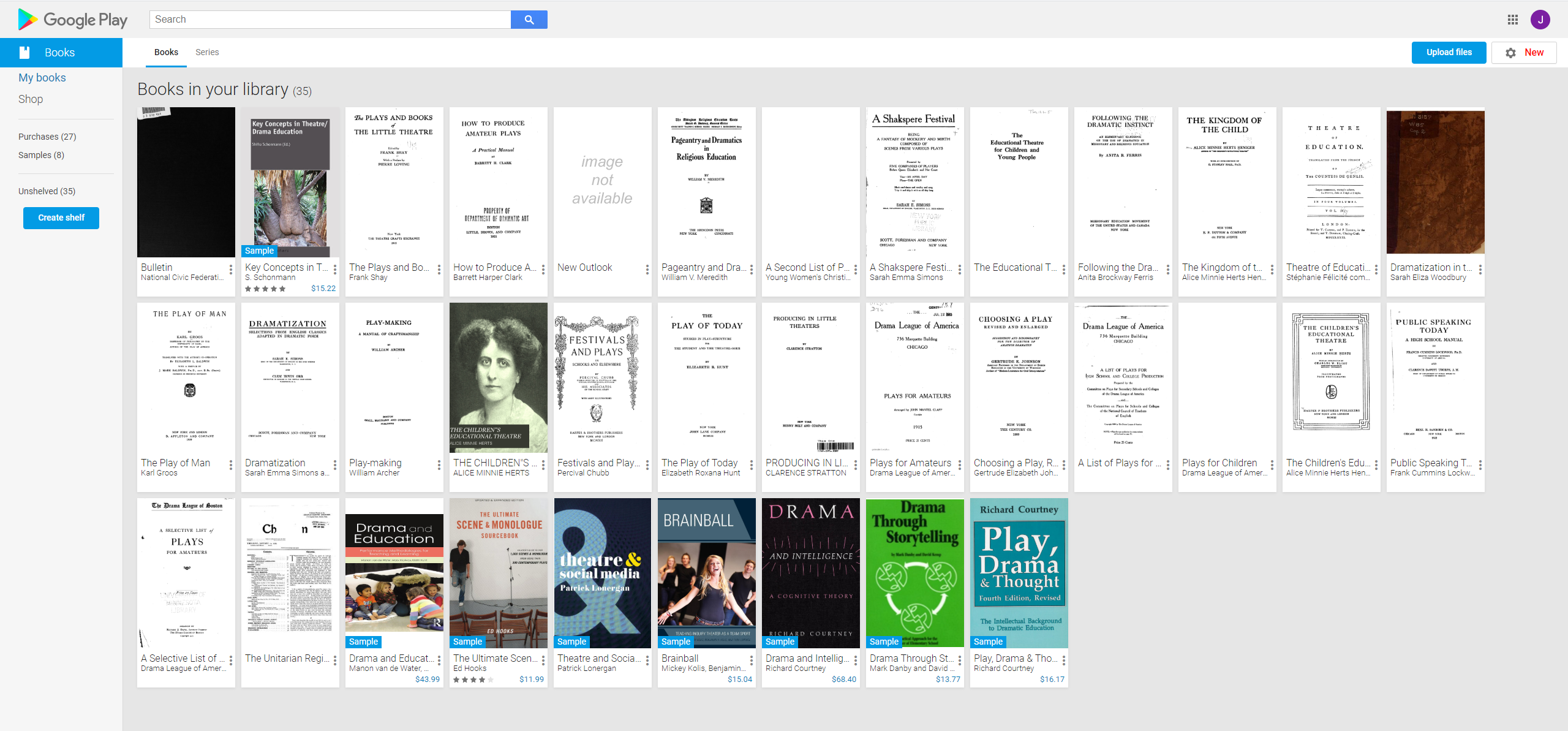
Google Books Library Screenshot
When you’re looking for public domain pieces, limit your search to “Full View,” and select a date range ending in 1924. You can search as far back as the 16th century, but because they’re scans of physical books, works from before 1700 are often more difficult to read.
Once you’ve located plays for your students to read, it’s easy to link to the book on your Google Classroom or Blackboard site.
Here are some collections of children’s and one-act plays I found on Google Books using Advanced Search.
Keep in mind that some of these pieces are over 100 years old, and all may reflect language, attitudes, and cultural mores of the time that are no longer used. Read carefully before assigning work to students; you may need to provide context for some of the pieces. See New Plays from Old Tales below for a particularly glaring example of this!
Children’s Plays on Google Books
Festival Plays: One-Act Pieces for New Year’s Day, St. Valentine’s Day, Easter, All Hallowe’en, Christmas and a Child’s Birthday by Marguerite Merington (1913)
Merrington’s collection includes a Halloween-themed piece featuring Sir Gawain (Gawayne in her script) of Arthurian legend. I do not want to be the director in charge of carrying out Merrington’s stage direction for the “Month of February” in Father Time and His Children:
“February is the shortest child, and walks with a skipping leap at every fourth step”
Fairy-Tale Plays and How to Act Them by Lady Florence Eveleen Eleanore Olliffe Bell (1896)
How can you resist a book “with numerous illustrations” by an artist named LANCELOT SPEED? I certainly can’t!
Lady Bell’s advice to those working with young players takes up 35 pages in her Introduction, AND her pages precede another 15 pages of “Directions for Dances” by a choreographer. Bell’s collection includes versions of Cinderella, Jack and the Beanstalk, and Rumpelstiltzkin (sic), as well as the less-often-seen The Tinder Box, Foolish Jack, and The Fisherman and His Wife.
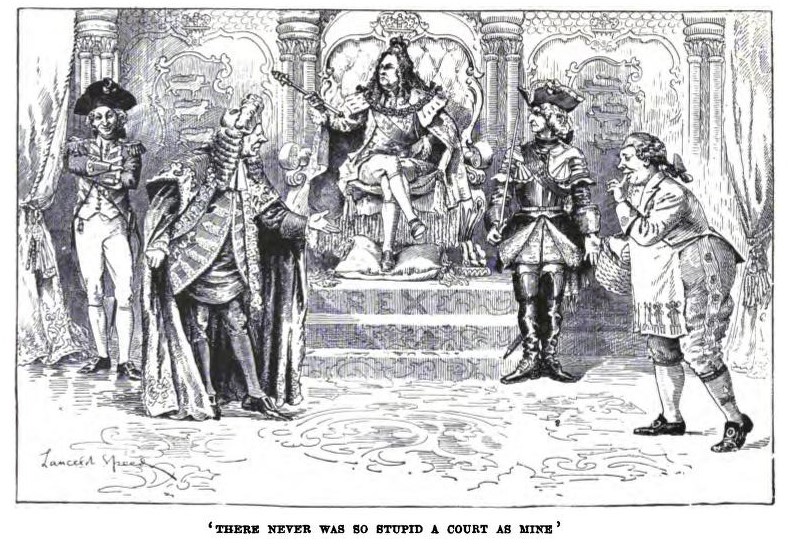
An Illustration of Rumplestiltzkin from Fairy Tale Plays and How to Act Them
Little Plays for Children: The Grinding Organ, Dumb Andy, The Dame School Holiday (Volume VII of The Parent’s Assistant) By Maria Edgeworth (1827)
This four-play collection is part of a popular series – The Parent’s Assistant – that began publication in 1796. The Preface has a frame story of a mother discussing this very text with her son and daughter at a bookseller’s, and the children’s insistence that the pieces be ENTERTAINING in addition to being “Warranted Harmless,” which I think means the plays won’t corrupt young and impressionable minds. The title Dumb Andy is an example of the archaic words in older works; the play features a character who’s pretending to be unable to hear or speak; the words “deaf and dumb” appear in reference to his feigned disability.
Children’s Plays by Eleanor L. Skinner and Ada M. Skinner (1921)
The Skinners include the cast breakdown on the Table of Contents for their 13 plays. They also supply Production Notes for the plays in an appendix.
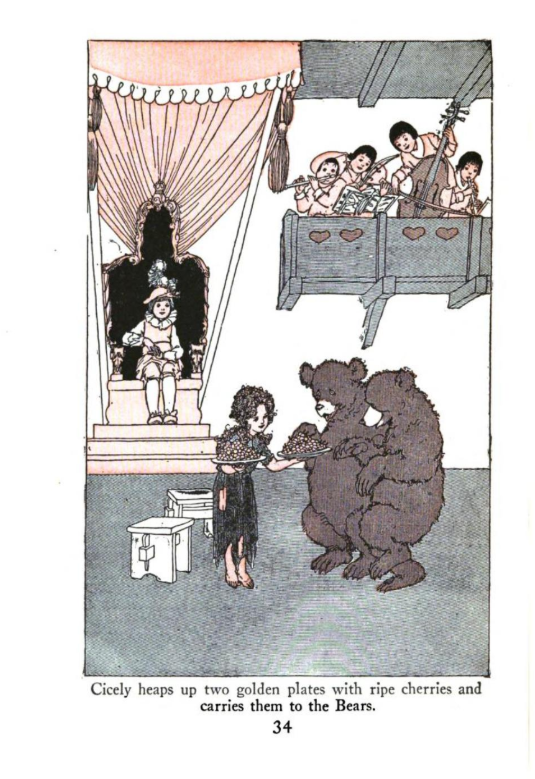
An Illustration of Cicely and Bears from Children’s Plays by Skinner – unlike many children’s play anthologies of the era, the pictures often look like that could happening on a stage with children playing the parts.
Neptune’s Isle and Other Plays for Children by John Jay Chapman (1911)
If you’re looking for children’s plays in iambic pentameter, here are four, including Wilfred the Young: A Dragon-Play for Boys (girls can be in it TOO, Mr. Chapman!)
A Treasury of Plays for Children edited by Montrose J. Moses (1921)
Moses assembled a 14-work collection. The Introduction to Frances Hodgson Burnett’s dramatization of her novel A Little Princess references Alice Minnie Herts Heininger’s work with the Children’s Educational Theatre in New York. (There’s a book available!)
Other notable works in this collection are The Months: A Pageant by Christina Rosetti and The Forest Ring by William C. De Mille and Charles Barnard
New Plays from Old Tales, Arranged for Boys and Girls by Harriet Sabra Wright (1922)
Wright appears to have read and performed these pieces with children in the New York Public Library’s Reading Clubs. She includes production notes with each piece. One charming example is: “If the one who takes the part of the Prince does not know how to play a lute, he may learn in time for the performance. That has happened.”
There are adaptations of Tamerlane (“Tamlane” here), The Pilgrim’s Progress, Poe’s “Three Sundays in a Week” and Hawthorne’s “Feathertop.”
HOWEVER, there’s also a piece based on Louise-Clarke Pyrnelle’s book Diddie, Dumps, and Tot. Its title is On the Old Plantation, and the four characters are enslaved African-Americans. The language and stereotyping throughout the introduction and script read like a parody of the romanticized versions of “plantation life” in the American South that Pyrnelle wrote. I was surprised that it was written 50 years after the Civil War, in the metropolitan setting of New York.
It might be useful for college classes studying minstrel shows, or literary depictions of African-Americans in the period between the Civil War and the Civil Rights Movement.
One-Act Plays on Google Books
Drawing-room Plays and Parlour Pantomimes edited by Clement Scott
Written in 1870 – a time before radio, the movies, or television – Scott’s collection features pieces for “private theatricals.” These are plays performed in people’s houses by friends and family as entertainment during social events. The Introduction to this collection has the remarkable statement: “However conscious we may have been that we are wretched actors, I doubt if any of us can honestly say that he or she has not been guilty of play-acting.”
One-Act Plays from the Yiddish translated by Etta Block (1923)
Block translates five one-acts, three by Peretz Hirschbein, originally presented in Yiddish.
Contemporary One-Act Plays of 1921 edited by Frank Shay (1922)
Shay’s selection of 20 one-acts has pieces by Eugene O’Neill, Edna St. Vincent Millay, and Christopher Morley. He includes a short list of “Books About the Theatre” and a longer one “Plays of the Little Theatre;” the latter lists plays within collections.
Representative One-Act Plays by Continental Authors edited by Montrose Jonas Moses (1922)
There are translations of works by fifteen different European playwrights here, including Frank Wedekind, August Strindberg, and Maurice Maeterlinck. Moses includes information about each author.
Representative One-Act Plays by American Authors edited by Margaret Gardner Mayorga (1919)
Mayorga arranged her collection of plays into genres of Fantasy, Poetic Drama, Impressionistic Episode, Play of Ideas, Morality, Dramatic Episode, Farce, Satire, Comedy, Tragedy, and Melodrama. She calls them “twenty-five of the most significant plays of the Little Theatre movement in America,” but I admit to only recognizing a few of the century-old titles.
Picture Plays by Marguerite Merington (1911)
Merington based each of the seven plays in this collection on a painting; Mona Lisa is the most well-known one.
Other play collections on Google Books –
Aphra Behn, Restoration playwright:
- Plays Written by the Late Ingenious Mrs. Behn
- The Plays, Histories, and Novels of Mrs. Aphra Behn (Volume 5)
Here are a few articles on Google Books:
- “Torching the Modern-Day Library of Alexandria” by James Somers in The Atlantic
- “How Google Book Search Got Lost” by Scott Rosenberg in Wired
If you’d like to learn more about public domain works, visit Duke Law’s Center for the Study of the Public Domain.
THIS POST IS PART OF THE TEACHING THEATRE ONLINE SERIES
